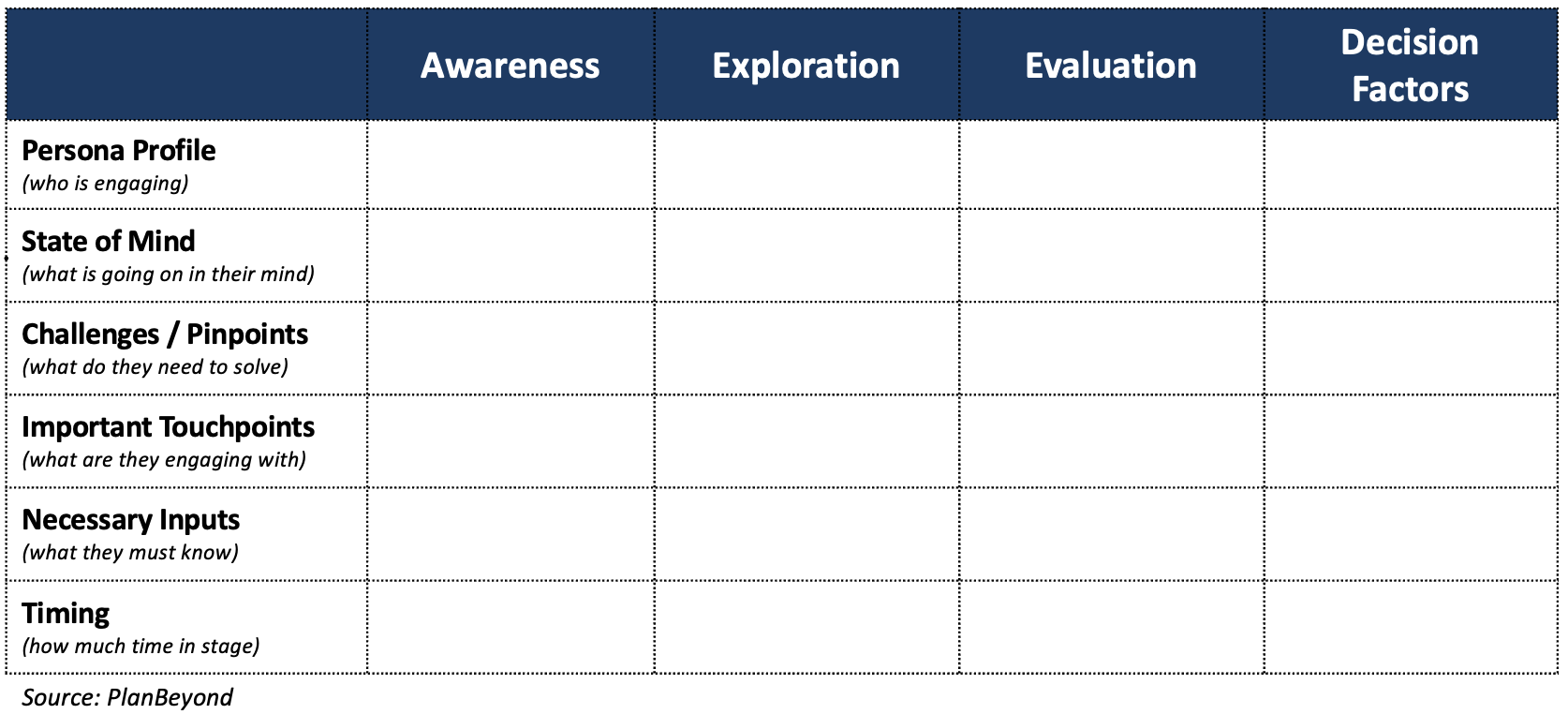How do you get a buyer from Point A to Point B? We bet there are a whole lot of things you think you can do. But, which of those is actually worth doing?
Ask some questions to find out!
Customer journey map research lets you visualize the unique steps users take when engaging with a product, service, or business. It puts you in the customer’s shoes during key stages, starting from their earliest moments with your business to when they decide to buy.
When you accurately know how buyers engage, you have the intel needed to effectively move them in the right direction.
What Is A Customer Journey Map
A customer journey map is a visual representation showing the stages buyers take when engaging with a product, service, or business, and their actions and perceptions during each stage.
Often, this covers the buyer journey, or they typical process individuals take to make an initial purchase. However, a customer journey map covers any type of user flow. This could include the process for engaging with customer service. Or, it could cover the typical churn process. If the process has unique stages and unique customer behaviors in each stage, you can likely create a journey map for it.
Why Should You Create A Customer Journey Map
Businesses develop customer journey maps to identify where and how to effectively influence customer decisions. Let’s take a look at just a few of the major factors that journey maps impact:
- Marketing Channels: Journey maps tell you where customers learn about you and what external factors influence their decisions. This knowledge informations which marketing activities an organization chooses.
- Marketing Collateral / Materials: Relatedly, journey maps tell you what information users look for during key experience stages. This equips businesses to develop the right mix of marketing collateral or other influencing materials for each stage.
- Personnel Resourcing: When you develop a journey map, you see who customers engage with to make a decision. This tells you if frontline sales staff, customer support reps, or other personnel are needed to create positive experiences.
- Budget: Businesses need to know how much money to set aside for marketing and sales. When you use customer journey maps to isolate channels, marketing materials, and personnel, you also gather the information needed to build budgets.
- Forecasting: Part of journey mapping includes assessing the amount of time users spend during journey stages. This informs revenue and customer acquisition forecasting activities.
How To Build A Data-Informed Customer Journey Map
Could you sit in a room with colleagues and create a generic customer journey map? Sure, you could. However, it would likely be fairly shallow. And, it would be fueled by internal anecdotes rather that customer feedback. This means you will miss key steps or inputs that yield effective, actionable maps.
Instead, let’s go through the process of developing data-informed customer journey maps.
Key Inputs To Cover In your Journey Maps
Customer journey map research starts with a basic framework. This framework outlines the stages in a specific journey and the dynamics we know we must understand at each stage. And, with a framework in place, we implicitly know what information we must gather to fill in the holes
Let’s review the diagram on the right to walk through this process.

Key Journey Map Stages
We know that any journey begins with an initial awareness stage, often triggered by a key event or need. From there, customers go through a series of additional stages to explore, evaluate, and ultimately decide on a final product or service. Our framework above covers most B2B contexts as well as several B2C contexts. However, this approach is likely too generic for certain business environments.
For instance, if we’re researching enterprise-oriented products, we likely need stages to explore the procurement, quoting, and negotiation process. Meanwhile, if our client is a B2B SaaS provider, we likely need to include pricing plan exploration as a standalone stage.
Essentially, be prepared to adapt the framework to your specific business context. As we’ll discuss below, you can use research to evaluate exactly which stages you should include.
Key Dynamics Within Each Journey Stage
A lot happens within each stage. That’s why the framework breaks out a wide variety of dynamics that must be understood about each stage. It’s the clarity we need to truly understand the buyer experience.
These are just a few of the dynamics we generally explore during our customer journey map research:
- Persona Profile: We need to know who the key stakeholder is at each stage in the journey, or if there are multiple stakeholders. Depending on the business context, this is often a mixture of demographic, psychographic, and professional details.
- State Of Mind: Getting into the heads of our customers helps us understand their everyday circumstances and empathize with them at each step of they way.
- Challenges / Pain points: We need to know the tangible problems customers must solve. These often evolve throughout the journey so be prepared to explore them throughout the process.
- Important Touch Points: This captures if there are key places, people, or things that our personas use to inform their decisions.
- Necessary Inputs: Information gathering is a key part of the buyer journey. Mapping out what customers learn during each stage helps you identify what questions you must answer, and when.
- Timing: Ideally, we have a strong grasp of how long customers take during each stage in the journey. This helps manage internal expectations about how long it takes to move people through the funnel.
Just like the journey stages, these dynamics may need adjustments for your specific business context
Filling In The Journey Map
Once you have a grasp for the journey map itself, and what inputs it needs, it’s time to actually fill it out. This is where market research comes in.
Because journey maps tend to be exploratory work, we typically leverage one-to-one customer research to complete these projects. That is, we use intentionally open-ended questions to explore and validate the the framework stages as well as the dynamics within each stage.
Using a structured discussion guide, we’ll have customers take us through their journey. By asking about a diverse range of topics, such as what triggered them to explore the category in the first place, what resources they used to evaluate the solution, and who they turned to for a second opinion, we capture the information needed to build these maps.
As we complete the interviews, we listen for repeated trends across participants. With enough interviews, patterns emerge that give us confidence to fill in those journey map squares.
Moving From Customer Journey Maps To Journey Flows
A customer journey map covers one discrete stage in the user’s experience with a product or service. However, as we alluded to above, users engage with a business under many different circumstances. As a result, their experiences flow from one circumstance to another. At some point, a new customer becomes an experienced customer. Meanwhile, key inflection points turn customers into evangelists or detractors.
Each transition point is an opportunity for an incremental customer journey map. It helps businesses visualize how users get from one stage to another. And, in doing so, it helps them drive customers toward desired outcomes.
This is why over time, you’ll want to build not just journey maps but also journey flows. These show how and when these transitions happen, empowering you once again to create positive journey experiences.






